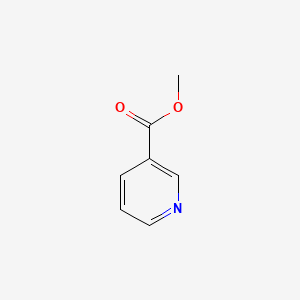



API Suppliers

US DMFs Filed
0

CEP/COS Certifications
0

JDMFs Filed
0
Other Certificates
Other Suppliers
0

USA (Orange Book)
0

Europe
0

Canada
0

Australia
0

South Africa
0
Uploaded Dossiers
0
U.S. Medicaid
0
Annual Reports
0
USFDA Orange Book Patents
0
USFDA Exclusivities
0
Blog #PharmaFlow
0
News
0
EDQM
0
USP
0
JP
0
Other Listed Suppliers
0
0


1. Methylnicotinate
1. 93-60-7
2. Methyl Pyridine-3-carboxylate
3. Nikomet
4. Methylnicotinate
5. Methyl-nicotinate
6. Nicometh
7. Nicotinic Acid Methyl Ester
8. Methyl 3-pyridinecarboxylate
9. 3-(methoxycarbonyl)pyridine
10. 3-pyridinecarboxylic Acid, Methyl Ester
11. Heat Spray
12. Nicotinic Acid, Methyl Ester
13. 3-(carbomethoxy)pyridine
14. 3-picolinic Acid Methyl Ester
15. M-(methoxycarbonyl)pyridine
16. Fema No. 3709
17. Methyl Nicotinate [usan]
18. Nsc 13126
19. 3pyrcoome
20. 3-pyridinecarboxylic Acid Methyl Ester
21. Heat Spray (tn)
22. 3-carbomethoxypyridine
23. Nsc-13126
24. 7b1avu9djn
25. Methyl Nicotinate (usan)
26. Ncgc00159479-02
27. Methyl Ester Of Pyridine-3-carboxylic Acid
28. Wln: T6nj Cvo1
29. Dsstox_cid_24471
30. Dsstox_rid_80253
31. Dsstox_gsid_44471
32. Cas-93-60-7
33. Einecs 202-261-8
34. Unii-7b1avu9djn
35. Brn 0113951
36. Ai3-19241
37. Methyl Nicotinoate
38. Nicotinato De Metila
39. Nicotinato De Metilo
40. Nicotinato Di Metile
41. Mfcd00006388
42. Nicotinate De Methyle
43. Nicotinic Acid Methyl
44. Methyl Nicotinate, 99%
45. Methylpyridine-3-carboxylate
46. Schembl24566
47. 5-22-02-00059 (beilstein Handbook Reference)
48. Methyl Nicotinate [mi]
49. Chembl379845
50. Zinc1706
51. Dtxsid7044471
52. Methyl Nicotinate [fhfi]
53. Methyl Nicotinate [inci]
54. Fema 3709
55. Methyl Nicotinate [vandf]
56. Chebi:134761
57. Methyl Nicotinate [mart.]
58. Methyl Nicotinate, >=99%, Fg
59. Hms1775a18
60. Methyl Nicotinate [who-dd]
61. Cs-d1355
62. Hy-b1695
63. Nsc13126
64. Tox21_111702
65. Tox21_302038
66. Nsc403799
67. S6231
68. Stk803258
69. Methyl Nicotinate, Analytical Standard
70. Akos000119439
71. Tox21_111702_1
72. Db13882
73. Gs-3032
74. Nsc-403799
75. Methyl Nicotinate [ep Monograph]
76. Pyridine-3-carboxylic Acid Methyl Ester
77. Ncgc00159479-03
78. Ncgc00159479-05
79. Ncgc00255708-01
80. Ac-22482
81. Db-031973
82. Am20061626
83. Ft-0645164
84. N0086
85. Methyl Nicotinate Methyl 3-pyridinecarboxylate
86. Methyl Nicotinate, Puriss., >=99.0% (gc)
87. D04991
88. D87532
89. Ac-907/25014170
90. Sr-01000944497
91. Q-201381
92. Q3341206
93. Sr-01000944497-1
94. Methyl Nicotinate;methyl 3-pyridinecarboxylate
95. F0001-2240
96. Methyl Nicotinate, European Pharmacopoeia (ep) Reference Standard
97. Methyl Nicotinate, Pharmaceutical Secondary Standard; Certified Reference Material
| Molecular Weight | 137.14 g/mol |
|---|---|
| Molecular Formula | C7H7NO2 |
| XLogP3 | 0.8 |
| Hydrogen Bond Donor Count | 0 |
| Hydrogen Bond Acceptor Count | 3 |
| Rotatable Bond Count | 2 |
| Exact Mass | 137.047678466 g/mol |
| Monoisotopic Mass | 137.047678466 g/mol |
| Topological Polar Surface Area | 39.2 Ų |
| Heavy Atom Count | 10 |
| Formal Charge | 0 |
| Complexity | 125 |
| Isotope Atom Count | 0 |
| Defined Atom Stereocenter Count | 0 |
| Undefined Atom Stereocenter Count | 0 |
| Defined Bond Stereocenter Count | 0 |
| Undefined Bond Stereocenter Count | 0 |
| Covalently Bonded Unit Count | 1 |
Indicated for the temporary relief of aches and pains in muscles, tendons, and joints.
Following topical administration, methyl nicotinate acts as a peripheral vasodilator to enhance local blood flow at the site of application. It induced vasodilation of the peripheral blood capillaries which are located in the dermal papillae of upper dermis layers adjacent to the epidermisdermis junction. During tissue penetration at the dermis, methyl nicotinate is hydrolyzed to nicotinic acid. In human volunteers, topical administration of methyl nicotinate caused vasodilation-induced generalized cutaneous erythema.
Absorption
The presence of methyl group facilitates the penetration of methyl nicotinate through the skin with good lipophilicity, allowing rapid absorption following topical administration. _In vitro_, about 80-90% of the polar compounds methyl nicotinate rapidly penetrated the skin. It was demonstrated in excised skin of hairless mice that methyl nicotinate can effectively bypass the stratum corneum layer of the skin. In humans, nicotinic acid and nicotinamide were shown to be rapidly absorbed from the stomach and intestine via a sodium carrier-mediated mechanism at low concentrations.
Route of Elimination
Following epicutaneous administration of small radiolabelled dose of methyl nicotinate in human volunteers, approximately 15% of the dose was recovered in the urine within 108 hours after treatment. The excretion of nicotinic acid mainly takes place in the kidneys.
Volume of Distribution
According to the animal studies, nicotinic acid is mainly concentrated in the liver, kidneys, and adipose tissue.
Clearance
No pharmacokinetic data available.
Methyl nicotinate undergoes ester hydrolysis to form nicotinic acid and methanol. The hydrolysis is thought to be mediated by nonspecific -naphthylacetate-esterase at the dermis layer of the skin.
_In vitro_, the half-life of methyl nicotinate in the dermis was 3 to 10 minutes.
While the mechanism of action of methyl nicotinate and other topically-administered nicotinic acid esters is not clear, it is thought that methyl nicotinate promotes the release of prostaglandin D2 that is strictly locally-acting due to its short half-life. It was demonstrated in human subjects that the local cutaneous vascular response to methyl nicotinic was suppressed by inhibitors of prostaglandin biosynthesis, indicating that the effect of methyl nicotinate on vascular smooth muscles may be mediated by the release of local prostaglandins. Prostaglandins released from the skin and blood vessels induce cutaneous vasodilation.


